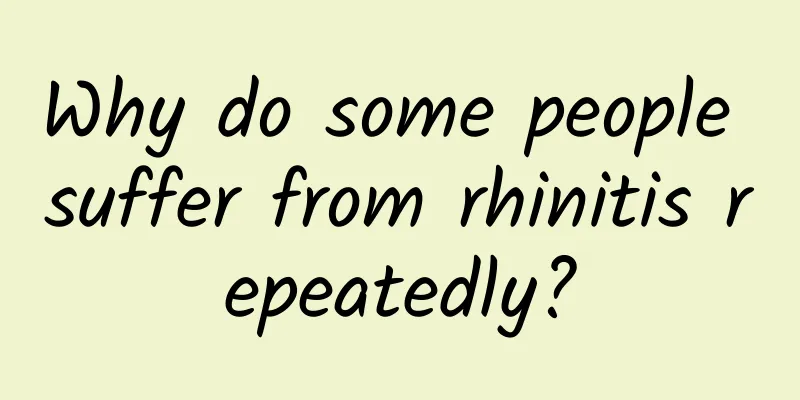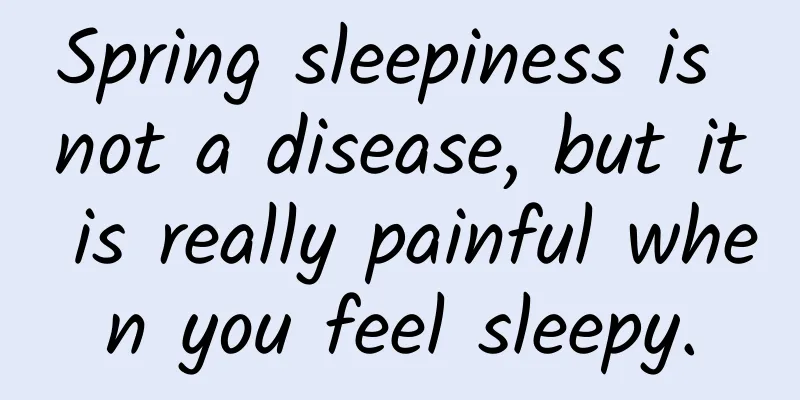Why do some people suffer from rhinitis repeatedly?

|
It is the season of transition from winter to spring again. Allergic rhinitis has begun to appear, making many people suffer. Why is rhinitis so difficult to cure? The reason why rhinitis is difficult to cure is essentially because of the scientific problem of "inflammation". The so-called treatment is essentially aimed at the inflammatory response and cannot fundamentally solve the problem of rhinitis. It is like "adding fuel to the fire" rather than "removing the firewood from the bottom of the pot". This is why rhinitis has become a "difficult and complicated disease" in a sense. Today, let's talk about rhinitis starting from inflammation. 01. What is inflammation? To understand rhinitis, we must have a basic understanding of inflammation. What is inflammation? Inflammation is an immunological concept. It refers to the body's defense response to stimulation, so the body shows redness, swelling, heat, pain and dysfunction. Don’t underestimate this seemingly simple sentence, it actually points out the core of rhinitis very accurately. First of all, rhinitis is a defensive reaction of the body to irritation. This is the characteristic of our body's immunity, which is used to protect us. When our nasal cavity is exposed to irritation, whether it is viruses, bacteria, pollen, haze, etc., these are judged as irritation by our body's immunity, then our body will respond. Secondly, symptoms such as redness, swelling, heat and pain are essentially side effects of immunity. For example, many people with rhinitis will experience nasal congestion, runny nose and other symptoms, and further symptoms such as loss of smell and even headache and dizziness. In fact, behind this is a series of chain reactions of inflammatory response. When our immune system senses the invasion of foreign objects, it begins to summon the body's immune power to deal with these invaders, such as immune cells and antibodies. When these immune substances arrive at the invasion site, that is, our nasal cavity, they encounter a very important problem: how to pass through? 02. How do immune tissues arrive in the nasal cavity? You should know that generally immune substances reach the battlefield mainly through blood circulation and lymphatic circulation, but on the battlefield, people also have normal tissue structures, such as the epithelial tissue of the nasal cavity. This basic physiological structure is very dense, and generally only small molecules can pass through smoothly. What to do? The immune system will bring a tool called histamine, which can increase the permeability of the blood vessel wall, allowing immune substances to pass through more easily to play a role. However, this increased permeability is also a double-edged sword. Immune substances can pass through, and so can other substances. As a result, water in the blood seeps out, resulting in increased mucus and nasal congestion. The same is true for redness and swelling. I believe that you have roughly understood that our rhinitis is actually a series of symptoms caused by the body's immunity. When you have rhinitis, it means that the body's immunity is fighting against irritants. Just like when we have cold symptoms, it is actually our body fighting against the cold germs, and the battlefield damage of the fight is borne by our body. Because of this, the fundamental way to deal with rhinitis is to solve the problem of irritants. Of course, if this immune process causes physical discomfort, we will use medication to deal with this discomfort, and this is the essence of what we call "treating rhinitis." Because of this, treating rhinitis and what we often call curing diseases is actually reducing the intensity of the body's immune response. There are certain medical methods for this. 03. Medical treatments for rhinitis Since it is an immune response, it targets immunity, such as glucocorticoids, which can be called a "nuclear weapon" to deal with immunity. It is a very common regulatory factor in the body secreted by the zona fasciculata of the adrenal cortex. Anti-inflammatory and immune suppression are its important functions. Therefore, when encountering acute and severe rhinitis, it can go straight up and kill all around. Of course, this thing also has a problem, that is, it is easy to produce side effects. After all, it is a very broad-spectrum thing, so, under normal circumstances, it should be used with caution. Secondly, there are antihistamines, the goal of which is to reduce the secretion of histamine. As we mentioned earlier, histamine is an expander brought by immunity, which will cause us symptoms such as nasal congestion and runny nose. Reducing it will naturally relieve our rhinitis symptoms. In addition, there are a series of drugs including decongestants and anticholinergics. As shown in the table above, this is the content mentioned in the "Guidelines for the Diagnosis and Treatment of Allergic Rhinitis" jointly compiled by the Rhinology Group of the Editorial Committee of the Chinese Journal of Otolaryngology-Head and Neck Surgery and the Rhinology Group of the Chinese Medical Association's Otolaryngology-Head and Neck Surgery Branch [1]. However, I guess after reading this information, you probably understand why it is difficult to "cure" rhinitis in hospitals. Because, when we say rhinitis, it is nasal discomfort caused by irritants, and the idea of curing it should be to keep us away from irritants or make our nasal cavity more resistant to these irritants, so that there will be no subsequent inflammatory reaction. But in fact, the treatment method is to ignore the previous step, but to relieve the symptoms of rhinitis. As long as we cannot avoid the immune response of rhinitis, then as long as we stop taking the medicine, rhinitis will come back immediately. The correct approach should be: remove the firewood from the bottom of the pot. 04. How to deal with rhinitis at the root of the problem? So how to do it? The basic immune components of rhinitis are: irritation and nasal cavity. So, we have to start from these two points. First of all, when it comes to irritation, we should stay away from irritation that causes rhinitis as much as possible. 1. Particles. The most typical one is pollen. Every spring when flowers bloom, many people are prone to allergies when facing flowers and plants. This is because many pollen particles float in the wind and finally reach the nasal cavity with our breath, resulting in rhinitis, etc. However, there is a misunderstanding. In fact, it is often not the many flowers and plants we see on the ground that can make us allergic. Their pollen particles are large and are often spread by insects, which are not easy to float. Instead, it is the wind-pollinated plants with small pollen particles that are easy to float in the air, such as cypress, sycamore, etc. In fact, another thing that is easily overlooked is smog. Smog particles will enter the nasal cavity with breathing, and then accumulate in the nasal mucosa. These particles are difficult to degrade, resulting in damage to the nasal mucosa and being recognized by the immune system, thus causing rhinitis. In this case, staying away from allergens or wearing a mask can filter out certain rhinitis factors. 2. Cold air is also a factor in rhinitis. Some people may have noticed that rhinitis is more likely to occur when it is cold. In fact, this is related to changes in air temperature. This is because the air is dry and cold in winter, and the nasal cavity, as the first step for air to enter the human body, is naturally susceptible to the influence of dry and cold air and damages the mucosa. In addition, dry and cold air itself will stimulate the secretion of inflammatory factors in mast cells and immune cells, making rhinitis symptoms more likely to occur. These factors are actually difficult to completely avoid, after all, the environment is difficult to fully control. The second is nasal washing. I believe you must have searched for methods and treatments for rhinitis. Many plans will directly recommend you to wash your nasal cavity. Don’t think this is just a casual remark. It is written in the guidelines. For example, the “Expert Consensus on the Classification and Diagnosis of Rhinitis and Nasal Medication Regimens” clearly states that the use of nasal saline wash is the standard strategy for the treatment of rhinitis [2]. Why can washing with salt water effectively improve nasal symptoms such as nasal congestion and runny nose to a certain extent? It is mainly because it removes nasal irritants and improves the condition of the nasal cavity. External irritants are the key factor causing rhinitis. We rely on the body to automatically remove them on a daily basis. However, for patients with rhinitis, this removal is not enough, so it is a good idea for us to take the initiative to help clean them. In addition, if the viscous secretions in the nasal cavity remain in the nasal cavity, these irritants will continue to irritate, so cleaning it will help reduce these irritants. In addition, long-term contact with irritants in the nasal mucosa can easily cause edema, further aggravating the rhinitis. Washing can reduce nasal edema and improve nasal ventilation and drainage, so that we can relieve rhinitis to a certain extent. Many studies have also confirmed the effect of washing the nasal cavity on relieving rhinitis [3]. Of course, washing the nasal cavity requires some care. The hospital can use a special negative pressure device for washing. Going to the hospital all the time is not a solution, but now there are many special nasal washers. 05. How to choose a nasal washer? However, when choosing a nasal aspirator, you should also pay attention to the following specific contents: 1. Electric vs. manual. For this, choose the electric one without a doubt. If it is a manual one, imagine the feeling of water rushing into your nose all of a sudden if you can't control the pressure well. Don't overestimate your ability to do it manually. The water pressure fluctuates, which is very troublesome. Not to mention that when you want to flush your nose, you have to free your hands to operate it, which is really not a good experience. 2. Spray type vs flush type. Compared with flush type, the spray type has lower water pressure, so it is generally used for infants or babies with low cooperation, but the effect is naturally not as good as the flush type. For adults, the flush type is preferred. 3. Positive pressure vs. negative pressure. Flushing nasal washers are generally divided into two categories: positive pressure and negative pressure. The former can provide continuous flushing at a certain frequency, but if the pressure is too high, a stress response may occur. Negative pressure relies on the principle of negative pressure suction, so the water flow can be relatively gentle. One of the concerns of many people about nasal washing is the discomfort caused by choking or water flow, and negative pressure can effectively reduce these. One thing that needs to be explained here is that you need to use normal saline to clean your nose. Ordinary water has no osmotic concentration, which will cause a concentration difference in the nasal cavity, which will affect the nasal mucosa and aggravate the edema of the nasal mucosa. Therefore, cleaning the nasal cavity must be done with a liquid of a certain concentration, at least isotonic, or not hypertonic. If you have rhinitis problems and current medicine is difficult to cure, you might as well try a relief strategy. 1. Rhinology Group, Editorial Committee of Chinese Journal of Otorhinolaryngology Head and Neck Surgery, and Rhinology Group, Chinese Society of Otorhinolaryngology Head and Neck Surgery. "Guidelines for the diagnosis and treatment of allergic rhinitis (2015, Tianjin)." Chinese Journal of Otorhinolaryngology Head and Neck Surgery 51, no. 1 (2016): 6-24. 2. Li Huabin, Wang Xiangdong, Wang Hongtian, Tan Guolin, Chen Jianjun, Xu Rui, Meng Juan, et al. "Expert consensus on the classification and diagnosis of rhinitis and nasal medication regimen." Chinese Journal of Otorhinolaryngology and Skull Base Surgery 25, no. 6 (2019): 573-577. 3. Lu Yulan, Chen Zhong, Li Lan. Observation on the efficacy of saline nasal irrigation in the treatment of allergic rhinitis[J]. Chinese Community Physician, 2020, 36(30): 49-50. |
>>: What is a leap year? Why is there an extra day every 4 years?
Recommend
How much does a generator cost? How much does a household generator cost?
The prices of units of different brands and confi...
Gained 3 pounds during the Spring Festival? Be careful, this "lipid-lowering injection" cannot be used to lose weight!
The sound of firecrackers during the Spring Festi...
Operational strategy: How to effectively recall lost users?
User churn is a very troubling problem for operat...
HTTPS vulnerability exposes 1,500 iOS apps to security vulnerabilities
SourceDNA, an app analytics service company, rele...
7 essential promotion skills for operators! Did you know?
01 Promotion skills For operations personnel, whe...
Is it useful to develop a tourist visa mini program? What is the best way to do it?
The domestic economy has developed very rapidly i...
How can products get more users to pay? Share 3 tips!
When a product enters the mature stage and has en...
Job hopping at the slightest disagreement: product operation, App promotion, SEM, UI design, new media operation (latest job search and recruitment information)
Job Information Latest: Job search, Shanghai area...
Is there any scientific basis for strictly controlling electronic products to protect eyesight?
In order to protect their children's eyesight...
Microsoft explains iOS app porting project: Sandbox-free access to Win10 API
Currently, Microsoft's Android application po...
Marketing Promotion: Where do brainwash advertisements come from?
To a certain extent, brainwashing advertising ach...
People are trapped! How to avoid danger and save yourself after a flooding accident?
At about 23:00 on December 15, 2021, an illegal m...
Good news: Typhoon Makar is gone! Bad news: It’s coming again…
In the past two days, the super typhoon "Mak...
There are 13 ways to play activities in the 2020 event planning plan
In 2020, will you continue with last year’s old r...
Timely warning and comprehensive deployment in many places to actively respond to blizzards and cold waves
Affected by the cold wave, the temperature in the...









